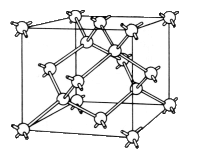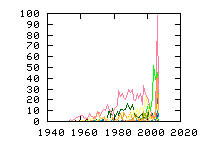« Previous
1
Next »
(19 hits, 1/1)
Showing
10, 25, 50, 100, 500, 1000, all papers per page.
Sort by:
last publication date,
older publication date,
last update date.
- 1. phys. stat. sol. (b) 245, 1298-1314 (2008) , “EPR identification of intrinsic defects in SiC”, J. Isoya, T. Umeda, N. Mizuochi, N. T. Son, E. Janzen, T. OhshimaThe structure determination of intrinsic defects in 4H-SiC, 6H-SiC, and 3C-SiC by means of EPR is based on measuring the angular dependence of the 29Si/13C hyperfine (HF) satellite lines, from which spin densities, sp-hybrid ratio, and p-orbital direction can be determined over... (Read more)Si SiC diamond| EPR Theory electron-irradiation thermal-meas./anneal-exp.| +1 -1 0(neutral) 1.0eV~ 13C 29Si C1h C3v Carbon Csi D2d EI5/6 HEI1 HEI9/10 P6/7 Silicon T1 Td Tv2a V1/2/3 Vc Vsi antisite dangling-bond mono(=1) motional-effect n-type p-type pair(=2) quartet semi-insulating spin-relaxation triplet vacancy .inp files: SiC/Baranov/Baranov_g.inp SiC/EI5_C1h/5.inp SiC/EI5_C3v/5.inp SiC/EI6_RT/6.inp SiC/HEI10/HEI10a.inp SiC/HEI10/HEI10b.inp SiC/HEI1_C1h/1.inp SiC/HEI9/HEI9a.inp SiC/HEI9/HEI9b.inp SiC/SI5_C1h/4.inp SiC/Ky2/Ky2.inp SiC/Tv2a/Main.INP SiC/Vsi-_II_4H/Main.INP SiC/Vsi-_II_6H/Main.INP SiC/Vsi-_I_4H/Main.INP SiC/Vsi-_I_6H/Main.INP | last update: Takahide Umeda
- 2. Phys. Rev. B 75, 245202 (2007) , “Identification of positively charged carbon antisite-vacancy pairs in 4H-SiC”, T. Umeda, J. Ishoya, T. Ohshima, N. Morishita, H. Itoh, and A. GaliAn antisite-vacancy pair and a monovacancy are a set of fundamental stable and/or metastable defects in compound semiconductors. Theory predicted that carbon antisite-vacancy pairs would be much more stable in p-type SiC than silicon vacancies and that they would be a common defect. However,... (Read more)
- 3. Phys. Rev. B 75, 115418 (2007) , “Early stages of radiation damage in graphite and carbon nanostructures: A first-principles molecular dynamics study”, Oleg V. Yazyev, Ivano Tavernelli, Ursula Rothlisberger, and Lothar HelmUnderstanding radiation-induced defect formation in carbon materials is crucial for nuclear technology and for the manufacturing of nanostructures with desired properties. Using first-principles molecular dynamics, we perform a systematic study of the nonequilibrium processes of radiation damage in... (Read more)
- 4. Phys. Rev. B 75, 085208 (2007) , “Clustering of vacancy defects in high-purity semi-insulating SiC”, R. Aavikko, K. Saarinen, F. Tuomisto, B. Magnusson, N. T. Son, and E. JanzénPositron lifetime spectroscopy was used to study native vacancy defects in semi-insulating silicon carbide. The material is shown to contain (i) vacancy clusters consisting of four to five missing atoms and (ii) Si-vacancy-related negatively charged defects. The total open volume bound to the... (Read more)
- 5. Phys. Rev. Lett. 98, 185501 (2007) , “Enhanced Ductile Behavior of Tensile-Elongated Individual Double-Walled and Triple-Walled Carbon Nanotubes at High Temperatures”, J. Y. Huang, S. Chen, Z. F. Ren, Z. Wang, K. Kempa, M. J. Naughton, G. Chen, and M. S. DresselhausWe report exceptional ductile behavior in individual double-walled and triple-walled carbon nanotubes at temperatures above 2000 °C, with tensile elongation of 190% and diameter reduction of 90%, during in situ tensile-loading experiments conducted inside a high-resolution transmission... (Read more)
- 6. Phys. Rev. B 74, 245420 (2006) , “Energetics, structure, and long-range interaction of vacancy-type defects in carbon nanotubes: Atomistic simulations”, J. Kotakoski, A. V. Krasheninnikov,, and K. NordlundThe presence of vacancy clusters in carbon nanotubes has been assumed to explain the formation of carbon peapods and the difference between the experimentally measured and theoretical fracture strength of nanotubes. We use atomistic simulations at various levels of theory to study the... (Read more)
- 7. Phys. Rev. B 74, 235201 (2006) , “Annealing of multivacancy defects in 4H-SiC”, W. E. Carlos, N. Y. Garces, E. R. Glaser, and M. A. FantonThe annealing behavior of defects observed in electron paramagnetic resonance (EPR) and photoluminescence (PL) is discussed. We consider the divacancy (the P6/P7 EPR centers) and a previously unreported EPR center that we suggest is a VC-VSi-VC... (Read more)
- 8. Phys. Rev. B 74, 165404 (2006) , “Density functional study of gold atoms and clusters on a graphite (0001) surface with defects”, Jaakko Akola and Hannu HäkkinenAdsorption of gold atoms and clusters (N=6) on a graphite (0001) surface with defects has been studied using density functional theory. In addition to perfect graphite (0001), three types of surface defects have been considered: a surface vacancy (hole), a pyridinelike defect comprising three... (Read more)
- 9. Phys. Rev. B 74, 161203(R) (2006) , “Room-temperature manipulation and decoherence of a single spin in diamond”, R. Hanson, O. Gywat, and D. D. AwschalomWe report on room-temperature coherent manipulation of the spin of a single nitrogen-vacancy center in diamond and a study of its coherence as a function of magnetic field. We use magnetic resonance to induce Rabi nutations and apply a Hahn spin echo to remove the effect of low-frequency dephasing.... (Read more)
- 10. Phys. Rev. B 74, 153403 (2006) , “Doping and the unique role of vacancies in promoting the magnetic ground state in carbon nanotubes and C60 polymers”, Antonis N. Andriotis, R. Michael Sheetz, and Madhu MenonThe role of various types of defects in establishing the magnetic properties of the C60-based polymers and the single-wall carbon nanotubes is investigated. Comparing the role of carbon vacancies, and that of substitutional impurity atoms X (X=N, B, O, Si, P, and S) in... (Read more)
- 11. Phys. Rev. Lett. 96, 55501 (2006) , “Divacancy in 4H-SiC”, N. T. Son, P. Carlsson, J. ul Hassan, E. Janz?n, T. Umeda, J. Isoya, A. Gali, M. Bockstedte, N. Morishita, T. Ohshima, H. ItohElectron paramagnetic resonance and ab initio supercell calculations suggest that the P6/P7 centers, which were previously assigned to the photoexcited triplet states of the carbon vacancy-antisite pairs in the double positive charge state, are related to the triplet ground... (Read more)
- 12. Phys. Rev. Lett. 96, 145501 (2006) , “Identification of the Carbon Antisite-Vacancy Pair in 4H-SiC”, T. Umeda, N. T. Son, J. Isoya, E. Janzn, T. Ohshima, N. Morishita, H. Itoh, A. Gali, M. BockstedteThe metastability of vacancies was theoretically predicted for several compound semiconductors alongside their transformation into the antisite-vacancy pair counterpart; however, no experiment to date has unambiguously confirmed the existence of antisite-vacancy pairs. Using electron paramagnetic resonance and first principles calculations we identify the SI5 center as the carbon antisite-vacancy pair in the negative charge state (CSiVC-) in 4H-SiC. We suggest that this defect is a strong carrier-compensating center in n-type or high-purity semi-insulating SiC. (Read more)SiC| ENDOR EPR Theory electron-irradiation optical-spectroscopy thermal-meas./anneal-exp.| -1 -2 1.0eV~ 13C 29Si C1h C3v Carbon Csi EI5/6 HEI1 HEI5/6 Nitrogen P6/7 SI5 Silicon Vc antisite bistable/metastable dangling-bond n-type pair(=2) semi-insulating vacancy .inp files: SiC/SI5_C1h SiC/SI5_80K SiC/SI5_100K | last update: Takashi Fukushima
- 13. Phys. Rev. B 71, 193202 (2005) , “EPR and theoretical studies of negatively charged carbon vacancy in 4H-SiC”, T. Umeda, Y. Ishitsuka, J. Isoya, N. T. Son, E. Janz?n, N. Morishita, T. Ohshima, H. Itoh, A. GaliCarbon vacancies (VC) are typical intrinsic defects in silicon carbides (SiC) and so far have been observed only in the form of positively charged states in p-type or semi-insulating SiC. Here, we present electron-paramagnetic-resonance (EPR) and photoinduced EPR (photo-EPR)... (Read more)
- 14. Phys. Rev. B 70, 235212 (2004) , “EPR and theoretical studies of positively charged carbon vacancy in 4H-SiC”, T. Umeda, J. Isoya, N. Morishita, T. Ohshima, T. Kamiya, A. Gali, P. De?k, N. T. Son, E. Janz?nThe carbon vacancy is a dominant defect in 4H-SiC, and the "EI5" electron-paramagnetic-resonance (EPR) spectrum originates from positively charged carbon vacancies (VC+) at quasicubic sites. The observed state for EI5, however, has been attributed to a... (Read more)
- 15. Phys. Rev. B 69, 121201(R) (2004) , “EPR identification of two types of carbon vacancies in 4H-SiC”, T. Umeda, J. Isoya, N. Morishita, T. Ohshima, and T. KamiyaThe EI5 and EI6 centers are typical intrinsic defects in radiation-damaged and semi-insulating 4H-SiC. So far, their origins have been assigned to positively charged carbon vacancies (VC+) and silicon antisites (SiC+), respectively. However,... (Read more)
- 16. Phys. Rev. Lett. 92, 135502 (2004) , “Hydrogen Incorporation in Diamond: The Vacancy-Hydrogen Complex”, C. Glover, M. E. Newton, P. M. Martineau, S. Quinn, D. J. TwitchenWe report the identification of the vacancy-hydrogen complex in single crystal diamond synthesized by chemical vapor deposition. The S = 1 defect is observed by electron paramagnetic resonance in the negative charge state. The hydrogen atom is bonded to one of the carbon atoms neighboring the... (Read more)
- 17. Phys. Rev. Lett. 90, 185507 (2003) , “Hydrogen Incorporation in Diamond: The Nitrogen-Vacancy-Hydrogen Complex”, C. Glover, M. E. Newton, P. Martineau, D. J. Twitchen, J. M. BakerWe report the identification of the nitrogen-vacancy-hydrogen complex in a freestanding nitrogen-doped isotopically engineered single crystal diamond synthesized by chemical vapor deposition. The hydrogen atom is located in the vacancy of a nearest-neighbor nitrogen-vacancy defect and appears to be... (Read more)
- 18. Phys. Rev. B 59, 12900 (1999) , “Electron-paramagnetic-resonance measurements on the divacancy defect center R4/W6 in diamond”, D. J. Twitchen, M. E. Newton, J. M. Baker, T. R. Anthony, W. F. BanholzerElectron-paramagnetic-resonance (EPR) studies in radiation damaged diamond enriched to 5% 13C have resulted in the identification of the nearest-neighbor divacancy center. It is the isotopic enrichment, and consequent observation of 13C hyperfine lines, that has permitted the... (Read more)
- 19. phys. stat. sol. (b) 210, 13 (1999) , “Neutral Vacancies in Group-IV Semiconductors”, A. Zywietz, J. Furthmüller, F. BechstedtAb initio plane-wave-supercell calculations are performed for the neutral monovacancies in silicon, silicon carbide and diamond using ultrasoft non-normconserving Vanderbilt pseudopotentials. We study the structure, the energetics and the single-particle energy spectrum. The local symmetry, the... (Read more)
« Previous
1
Next »
(19 hits, 1/1)
Showing
10, 25, 50, 100, 500, 1000, all papers per page.
Sort by:
last publication date,
older publication date,
last update date.
All papers (3399)
Updated at 2010-07-20 16:50:39
Updated at 2010-07-20 16:50:39
(view as: tree
,
cloud
)
| 1329 | untagged |
Materials
(111 tags)
Others(101 tags)
Technique
(46 tags)
Details
(591 tags)
Bond(35 tags)
Defect(interstitial)(18 tags)
Defect(vacancy)(15 tags)
Defect-type(19 tags)
Element(65 tags)
Energy(8 tags)
Isotope(56 tags)
Label(303 tags)
Sample(17 tags)
Spin(8 tags)
Symmetry(15 tags)

